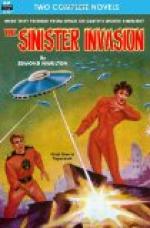He retraced his steps to the spot where they’d caught the first whiff of that disgusting reptilian-jungle-decay odor which had bombarded their nostrils. Jill called anxiously, “Be careful!”
He nodded. He got the coiled bronze watchspring out of his pocket. He went very cautiously to the spot where the smell became noticeable. Standing well back from it, he tossed one end of the spring into it. He drew it back. He repeated the operation. He moved to one side. Again he swung the gold-colored ribbon. He dangled it back and forth. Then he drew back yet again and wrapped his left hand and wrists with many turns of the thin bronze spring, carefully spacing the turns. He moved forward once more.
He came back, his expression showing no elation at all.
“No good,” he said unhappily. “In a way, it works. The spring acts as an aerial and picks up more of the beam than my hand. But I tried to make a Faraday cage. That will stop most electromagnetic radiation, but not this stuff! It goes right through, like electrons through a radio tube grid.”
He put the spring back in his pocket.
“Well,” he grimaced. “Let’s go on again. I had a little bit of hope, but some smarter men than I am haven’t got the right gimmick yet.”
They started off once more. And this time they did not choose a path for easier travel, but went up a steep slope that rose for hundreds of feet to arrive at a crest with another steep slope going downhill. At the top Lockley said sourly, “I did discover one thing, if it means anything. The beam leaks at its edges, but it’s only leakage. It doesn’t diffuse. It’s tight. It’s more like a searchlight beam than anything else in that way. You can see a light beam at night because dust motes scatter some part of it. But most of the light goes straight on. This stuff does the same. It’s hard to imagine a limit to its range.”
He trudged on downhill. Jill followed him. Presently, when they’d covered two miles or more with no lightening of his expression, she said, “You said you understand how it works. Radio and radar beams don’t have effects like this. How does this have them?”
“It makes high frequency currents on the surface of anything it hits. High frequency doesn’t go into flesh or metal. It travels on the surface only. So when this beam hits a man it generates high frequency on his skin. That induces counter currents underneath, and they stimulate all the sensory nerves we’ve got—of our eyes and ears and noses as well as our skin. Every nerve reports its own kind of sensation. Run current over your tongue, and you taste. Induce a current in your eyes, and you see flashes of light. So the beam makes all our senses report everything they’re capable of reporting, true or not, and we’re blinded and deafened. Then the nerves to our muscles report to them that they’re to contract, and they do. So we’re paralyzed.”




